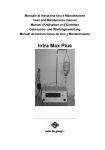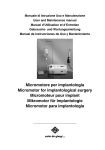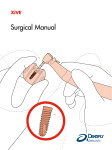Download Periotest M operating instructions english version 2015-03-17
Transcript
PERIOTEST M Operating Instructions English PERIOTES TM Medizintechnik Gulden e.K. Operating Instructions Electrical measuring instrument for dentistry and dental implantology Page 2 PERIOTEST M Electrical measuring instrument for dentistry and dental implantology Operating Instructions English Page 3 About this document Dear Customer, Thank you for purchasing the Medizintechnik Gulden Periotest M. The technical documentation supplied is part of the product and always must be kept within easy reach. Please read these Operating Instructions carefully and familiarize yourself with the Periotest M. If you encounter unsolvable problems after thoroughly studying the Operating Instructions, please contact your dental depot or the manufacturer. Symbols used in the Operating Instructions To prevent any personal injury or material damage, please observe the warning and safety information provided in the present operating instructions. All such information is highlighted as follows: NOTE Additional information, explanation or supplement. CAUTION WARNING Page 4 The information provided unter this keyword directly concerns the functioning of the product and / or warns against possible operating errors. The warning symbol warns against possible hazards for the product or the user. Symbols used in these Operating Instructions as well as on the product and the package VAC (volts alternating current): Alternating current in volts. VDC (volts direct current): Direct current (DC) in volts. f Serial number of the unit Electrical protection class: II (double insulation, complies with the requirements of IEC 60601-1. Part applied to patient: Type B. N M Manufacture date: Date written as year-month. Name and address of the manufacturer. Disposal: This product must not be disposed with household garbage. h Order number / item number Page 5 Storage and transport conditions Temperature: The product must not be stored and transported at temperatures ranging outside of -20 °C and +50 °C (-4 °F and +122 °F). Air pressure: Permissible atmospheric pressure: 500 to 1060 hPa. Humidity: Permissible relative humidity: 20 to 90 %. Observe information in accompanying documents. Fragile; handle with care. p C 0366 Item number and Version of Operating Instructions Page 6 Protect from moisture. This product bears the CE mark in accordance with the provisions of Council Directive 93/42/EEC of June 14, 1993 concerning medical devices. REF 8920165 Version 2015-03-17 Contents Page 1. Warning and safety information 1.1 General safety information 8 2. Technical information 2.1 Technical description 2.2 Technical data 2.3 Service life of Periotest instruments 11 12 14 3. Scope of supply 14 4. Installing the Periotest M 15 5. Controls and functional elements 17 6. Operation 6.1 Putting the unit into operation 6.2 Functional test 18 19 7. Conducting measurements with the Periotest M 7.1 Sitting position of the patient 7.2 Point of application at the tooth / implant 7.3 Posture of the Periotest M 7.4 Measurement procedure 7.5 Point in time of measurements at dental implants 7.6 Measurement of the occlusal load 20 20 21 23 24 24 8. Meaning of the Periotest values 25 9. Care and cleaning 9.1 Cleaning and disinfection 9.2 Sterilization of the Periotest M probe 27 29 10. Battery 10.1 Charging the battery 30 11. Maintenance 31 12. Electromagnetic compatibility 32 Page 7 1 Warning and safety information 1.1 General safety information Retention of documentation Read carefully before starting! It is very important to make sure that this manual is stored together with the unit so that it will also be available at any time in the future. In case the unit is sold or the right to use is transferred to a different owner, make sure that the manual always remains located near the unit. This is necessary to ensure that the new owner can use the unit properly and has all required information. These instructions serve to promote safety. Be sure to read them carefully before installing and using the unit. This symbol is attached at the Periotest M to remind the user to observe the manual. Medical electrical devices may be used with reference to the risk of electrical shock, fire or mechanical hazards, according to IEC 60601-1 only. Intended use The Periotest M is an electrical measuring instrument for dentistry and dental implantology. It may be used only by qualified dental personnel. Modification of the device The device must not be modified without the permission of the manufacturer. Disclaimer Page 8 The manufacturer assumes no liability whatsoever in cases involving: - work or repairs performed by any personnel not authorized by the manufacturer or importer - an application which does not correspond to the ones described in this manual - the use of non-OEM components or any components not described in the section entitled Scope of supply. Electromagnetic compatibility To prevent potential risks from electromagnetic interference, no medical devices or other electronic devices may be operated in the immediate vicinity of the Periotest M (see Chapter 12 for recommended working clearances between Periotest M and portable and mobile RF communication devices). The device meets the currently applicable guidelines for electromagnetic compatibility (IEC 60601-1-2). This unit does not cause any harmful interference. However, it can receive interference from other devices, such as wireless transmitters, mobile communication devices, and other household appliances, including interference that may lead to undesirable functions. Special EMC precautions are required for the installation and operation of the Periotest M. These Operating Instructions contain the corresponding EMC information. Operating environment Never use this unit in the presence of flammable anesthetics or anesthetic agents mixed with air, oxygen or nitrogen. Malfunction or damage In case of malfunction or damage of the unit, stop using it immediately. Damaged instruments can cause injuries. Contact your dental dealer or the manufacturer. Connected devices The Periotest M may be used only with the supplied probe. The use of a different probe may lead to wrong readings. Sterilization Maximum sterilization temperature for the probe: 134 °C (273 °F). Page 9 Power supply Battery Side effects Return shipment for repair Disposal Page 10 The Periotest M is powered by a storage battery. The supplied power supply unit and the charger unit are used only to charge the battery, but not to operate the Periotest M. Do not use other charging devices than the supplied power supply unit and the supplied battery charger. The Periotest M is equipped with a built-in battery. Do not try to open the Periotest M casing and change the battery by yourself. The battery may only be replaced by an authorized dealer or the manufacturer. Until now, no side effects (e.g. necrosis) have been determined in connection with clinical use of the Periotest M. Parts returned for repair must always be disinfected prior to shipment to ensure that no innocent bystander is infected when unpacking and transporting them. It generally applies that any disposal of this product must comply with the relevant national regulations. Please observe the regulations applicable in your country. Within the European Economic Community, Council Directive 2002/96/EU (WEEE) requires environmentally sound recycling / disposal of electrical and electronic devices. Your product is marked with the adjacent symbol. Disposal of your product with domestic refuse is not compatible with the objectives of environmentally sound recycling / disposal. The black bar underneath the „garbage can“ symbol means that it was put into circulation after August 13, 2005 (see EN 50419:2005). Please note that this product is subject to Council Directive 2002/96/EU (WEEE) and the applicable national law of your country and must be recycled or disposed in an environmentally sound manner. Please contact your dental depot if final disposal of your product is required. 2 Technical information 2.1 Technical description The Periotest M is an electrical measuring instrument for use in dental practices. It is designed for the following range of applications: - Assessment of the osseointegration of dental implants - Diagnosis and assessment of periodontopathies. The Periotest M measures the damping characteristics of the periodontium and, indirectly, tooth mobility, which it outputs in the form of a Periotest value. - Assessment of the occlusal load - Control of the treatment‘s progress. The instrument‘s scale ranges from -8.0 to +50.0. The unit of measure is „Periotest values“. Periotest values correspond to the contact time of the probe with the measured object (tooth, implant). A short contact time corresponds to a low Periotest value, while a long contact time corresponds to a high Periotest value. The Periotest M is the result of a cooperation between experienced dental technicians and many years of experience in high-end electronics. It represents the state of the art in dental research technology. Contraindications The Periotest M should not be applied in the following cases: - All types of acute apical periodontitis - Acute trauma (dislocation, root fracture, alveolar process fracture). Page 11 2.2 Technical data Manufacturer Model Periotest M hand unit data Dimensions Material Housing (white parts) Housing (blue parts) Probe sleeve Tapping head Weight incl. battery Noise level Power supply Power consumption from battery charger during charging Battery type Voltage nominal Capacity typical Medizintechnik Gulden e.K. Periotest M type 3218 Approx. 180 x 31 x 40 mm ABS (Flammability HB) TPE (Flammability HB) Brass, nickel and chrome plated Stainless steel X8CrNiS18-9 Approx. 153 g < 65 dBA Battery driven device max. 225 mA Lithium-ion polymer 7.4 VDC 250 mAh Protection against electrical shock Protection class Internal power supply Degree of protection against electrical shock Applied part: type B Operating mode Intermittent operation: ON 4 sec. / OFF until next measurement Housing IP class IP20 Page 12 2.2 (continued): Technical data Energy transfer from the tapping head to the measured object (tooth, implant) Weight of the tapping head Range of the Periotest value scale Unit of measure Accuracy of measure Display resolution Max. 0.00018 Joule Approx. 9 g -8.0 to +50.0 Periotest values Scale range -8 to +19: +/- 1.0 Periotest value Scale range +20 to +50: +/- 2.0 Periotest value 0.1 Periotest value Operating conditions Temperature: 15 to 30 °C (59 to 86 °F) Relative humidity: 20 to 90 % Air pressure: 700 to 1060 hPa Transport and storage conditions Temperature: -20 to 50 °C (-4 to 122 °F) Relative humidity: 20 to 90 % Air pressure: 500 to 1100 hPa Periotest M battery charger data Input voltage Housing IP class Protection class Item number / order number 12 VDC IP20 II REF 8916793 Switch mode power supply unit data Manufacturer Type Input voltage Mains frequency Output voltage Output current Housing IP class Item number / order number Friwo FW7660M/12 100 to 240 VAC 50 to 60 Hz 12 VDC 800 mA IP40 REF 8919610 Page 13 2.3 Service life of Periotest M instruments When used as intended, the non-moving parts of Periotest M instruments have a typical service life of 5 years. Moving parts of Periotest M instruments have a typical service life of 3 years. However, no warranty claim can be inferred here, as wear may occur earlier or later than indicated above depending on use, frequency of sterilization and frequency of maintenance. If your Periotest M (the unit as a whole, or in parts) or the accessories shall not be used any more, do not dispose the product or the parts with household garbage. They can be posing a risk to the environment. Please return these parts to the manufacturer. Alternatively, there may be local recycling or collection points. 3 Scope of supply - Periotest M including probe REF 8917140 - Lithium-ion polymer battery (built-in) REF 8917025 - Switch mode power supply unit REF 8919610 - Battery charger REF 8916793 - Test sleeve REF 5950027 - Cleaning brush REF 5245758 - Operating Instructions REF 8920165 Page 14 4 Installing the Periotest M Remove the Periotest M and its accessories from the box and lay everything on a table. Before installing the Periotest M inspect everything for damage. Any damage which may have occurred during transport must be reported to the dealer within 24 hours after receipt of the goods. Check the contents of the box for completeness as described in section 3 (Scope of supply). CAUTION - This product is intended only for use by trained dental personnel. - Do not install the Periotest M near direct or indirect sources of heat. - Prior to initial use, all components of the Periotest M must be disinfected (see section 9). - The packaging of the unit or its accessories must not be used for sterilization. - While the battery is charging, make sure that the power supply plug can be easily reached to enable quick and easy disconnection from the mains supply. The charger should be placed on a level and sturdy surface. Make sure that the charger is in a secure position. Plug the supplied test sleeve into its holder on the rear side of the charger. Connect the charger with the power supply unit. Then plug the power supply unit into a mains socket. The LEDs on the charger and on the power supply unit will both light up green. Page 15 WARNING - The charger must not be placed in the patient environment while it is connected with the power supply unit. - Never touch the charging contacts AND the patient. Place the Periotest M into the charger. The Periotest M battery is being charged. The green LED at the charger starts blinking. Once the battery is fully charged, the LED stops blinking and lights up green constantly. PERIOTEST M Page 16 5 Controls and functional elements 1 - Power supply unit 2 - Battery charger 3 - Periotest M hand unit 4 - Test sleeve 5 - Cleaning brush 6 - Tip of the probe 7 - Mounting ring 8 - Start button 9 - LCD PERIOTEST M Page 17 6 Operation 6.1 Putting the unit into operation The Periotest M is intended solely to be driven by battery. It is not designed for mains operation (100 - 240 VAC). WARNING The Periotest M must not be connected with the mains supply (via charger and power supply) during operation. The Periotest M is disconnected from the mains supply by pulling the power supply unit out of the wall socket. Press the start button to switch on the unit. All segments on the display light up for approx. 2 seconds. Then a short melody plays, the display shows - - . and the Periotest M is ready to conduct measurements. NOTE The Periotest M does not have a switch off button. The device switches off automatically after approx. 3 minutes of idle state. If you have terminated your measurements, put the Periotest M back into the charger. PERIOTEST M Page 18 6.2 Functional test With the functional test as described hereinafter you verify the correct function and readings of the Periotest M. Please carry out the functional test every time before you take any measurement at a patient. Visually inspect the device. If you observe damage which could lead to a hazardous situation do not use the device. Contact your dental depot or the manufacturer first. The functional test is done by measuring the supplied test sleeve. Remove the Periotest M from the charger. Fit the test sleeve onto the tip of the probe. Press the start button to switch on the unit. After 2 seconds a melody plays and the unit is ready to measure. Hold the Periotest M horizontally and press the start button again. The measuring process starts. After the measuring cycle (approx. 4 seconds - 16 impulses) is finished, the short melody plays again and the reading is indicated on the display. The reading should match the value indicated on the test sleeve. A deviation of +/- 2.0 Periotest values is acceptable. In case of a higher deviation, or in case no reading at all is indicated, the Periotest M does not measure properly. Please observe the instructions in section 9.1 (Care and cleaning). Above all, the probe must be clean and dry, enabling the tapping head to move easily. If cleaning of the probe does not solve the problem, please contact your dealer. Remove the test sleeve from the tip of the probe and plug it onto the holder on the rear side of the charger. Page 19 7 Conducting measurements with the Periotest M 7.1 Sitting position of the patient Most favourable is an upright sitting position of the patient with a corresponding vertical position of the teeth / implants. But it is also possible to conduct measurements on patients in a lying position. The teeth of the maxilla and the mandible must not have contact to each other. However, the patient should open his mouth only a little bit and not too wide to enable an easy access to the molar area. 7.2 Point of application at the tooth / implant To measure natural teeth, the Periotest M must be positioned from vestibularly (buccally, labially) in direction of lingually / palatinally. The tapping head should hit the center of the lateral surface of the tooth. To measure dental implants, two measuring directions are relevant: 1. Accordingly to the measurement of natural teeth: Position of the Periotest M from vestibularly in direction of lingually / palatinally. Mainly the lingual wall is measured. 2. Alternatively, if anatomically possible and accessible: Position of the Periotest M from lingually / palatinally in direction of vestibularly. Mainly the vestibular wall is measured. One-piece implants are measured at the upper end of the implant (ball head or similar). Two-piece implants are not measured at the implant itself, but at the implant abutment, the gingiva former or the final crown. The preferred hitting point is right above the gingiva. Page 20 7.3 Posture of the Periotest M and positioning at the tooth / implant In order to get valid, meaningful and reproducible readings, the Periotest M must be held and positioned at the tooth / implant in a particular manner. Please observe carefully the following instructions. 1. Horizontal posture: You only get valid readings if the Periotest M is held (more or less) horizontally. A slight bending upwards or downwards (up to +/- 25°) will be accepted. 2. Distance between the tip of the probe and the tooth / implant: You need to have a certain distance between the tip of the probe and the tooth / implant. The valid distance is between 0.6 and 2.5 millimeters. If the device is held more closely than 0.6 mm or further away than 2.5 mm, there will be no valid reading. In the beginning it requires a little practice to meet the correct distance. We recommend to make some test measurements at demo tooth models or implants, before starting to measure „real“ teeth / implants. Page 21 PE RIO TE ST M 3. Right angle between the Periotest M and the tooth / implant: In order to get readings with the highest accuracy, place the Periotest M in a right angle (Periotest M horizontally, tooth / implant axis vertically). In the molar area, this is not always possible. Deviations up to 45° are acceptable but can lead to slightly different readings (+/- 1.0 Periotest value). Page 22 7.4 Measurement procedure WARNING Never touch the charging contacts on the rear side of the Periotest M AND the patient. Press the start button to switch on the unit. All segments on the display light up for approx. 2 seconds. Then a short melody plays, the display shows - - . - and the Periotest M is ready to conduct measurements. PERIOTEST M Press the start button again to start the measuring process. The measuring cycle consists of 16 impulses of the pressure sensitive tapping head against the measuring object (tooth, implant). For each valid impulse a low tone is emitted. Invalid impulses, for example due to a too high deviation from the correct posture of the Periotest M, are followed by a high tone. You can correct the posture of the Periotest M during the measuring process. Page 23 After the measuring cycle (approx. 4 seconds) is finished, the short melody plays again. At least 4 of 16 impulses must be valid in order to get a valid reading. A valid reading is shown on the display. If less than 4 impulses were valid, no reading will be indicated on the display. The display shows - - . -. To start a new measurement, press the start button again. The preceding reading will be erased. If you have finished the measurements, put the Periotest M back into the charger. The Periotest M does not have a switch off button. It switches off automatically after 3 minutes. 7.5 Point in time of measurements at dental implants You can take measurements in each stadium of the implantological process. Typical points in time are: - Directly after implant insertion (measuring the primary stability) - After the healing phase - After the final crown is installed 7.6 Measurement of the occlusal load To measure occlusal load, the patient should press his teeth together as if swallowing (to attain maximum intercuspidation). The measurement can be taken on the upper jaw with the teeth rows closed. To check occlusal adjustment, it is also possible to take measurements on the lower jaw. Page 24 8 Meaning of the Periotest values General The Periotest scale ranges from -8.0 to +50.0. The smaller the Periotest value, the higher the stability / damping degree of the tooth / implant. ATTENTION The Periotest M is a measuring instrument which has been extensively tested and proven for many years. Nevertheless, it cannot be excluded that the device is not working properly and the readings are not correct. For legal reasons, we need to point out that before starting any medical treatment you must not rely solely on the measured Periotest value. You rather need to collect more data to assure your diagnosis. Measurement of natural teeth Clinical degree of tooth loosening 0 I II III Periotest value - 8.0 to +9.9 +10.0 to +19.9 +20.0 to +29.9 +30.0 to +50.0 Furthermore, tables for natural teeth are available, showing Periotest values that can be expected in case of a healthy periodontium, for each tooth separately. Please see the professional literature for more information. Page 25 Measurement of dental implants Nowadays, a wide range of implant systems is available on the market. In principle, the Periotest M can be used at all of them. However, due to this multitude of implant systems, and the variation of the clinical situations, with regard to the meaning of the Periotest values, we can only give guideline values which represent a high and a low implant stability (osseointegration). Periotest value range Interpretation -8.0 to 0.0 Good osseointegration; the implant can be loaded +0.1 to +9.9 Clinical examination is required; loading of the implant might or might not be possible, depending on implant type and clinical situation Osseointegration is insufficient, the implant cannot be loaded +10.0 or higher Generally, in the first 2 - 3 weeks following implantation, implants lose a certain amount of stability. This is reflected by an increase in the Periotest values. After the healing phase, however, the Periotest values should be similar or lower to those immediately following implantation (primary stability). Persistent and significant higher Periotest values indicate either a destabilization of the implant, or a screw loosening, or an overloading of the implant, or an infection (e.g. periimplantitis). It is recommended to record the measured data, enabling to compare the different readings taken over time. Page 26 9 Care and cleaning ATTENTION Only the Periotest M probe can be sterilized. All other parts can not be sterilized. 9.1 Cleaning and disinfection Cleaning and disinfecting the surfaces After every use, the Periotest M must be disinfected or sterilized. Wipe off surfaces with surface disinfectants (wipe disinfection). You must choose only disinfectants that comply with the valid requirements of the respective national regulatory body or whose bactericidal, fungicidal and virucidal properties have verifiably been tested and approved accordingly. You can use for instance: PlastiSept cleaning foam from Alpro. Disinfection of the tapping head To disinfect the tapping head, unscrew the tip of the probe and wipe off the tapping head with disinfection wipes. Do not use soaking wet wipes. It is very important to avoid the disinfection fluid penetrate into the inner parts of the probe. If you use disinfection sprays, only spray from the side. Do not spray inside the probe, neither from the front side nor from the rear side. Never use oil or lubricants. Page 27 Cleaning the tip of the probe The tip of the probe must always be clean inside. To clean it, unscrew the tip from the probe. Look inside. If you observe impurities, please use the supplied cleaning brush to remove it. After each use of the brush, it must be cleaned, too. Use disinfection foam or spray. The brush will wear out over time. After 10 applications, the brush should not be used any more. A new brush can be ordered, item number 5245758. If the impurities inside the tip of the probe are not too adhesive, you can use cotton buds instead of the brush. ATTENTION You should always observe the following instructions for cleaning the Periotest M probe Do not allow liquids or oil to enter the inner parts of the probe. Do not spray liquids or oil into the probe, neither from the front, nor from the rear side. Repeated entry of such fluids will form a patina which prevents the tapping head from moving easily and results in malfunction. In the longer run, the contacts inside the probe and also in the probe drive will corrode which causes malfunction and can only be repaired by replacing the whole assembly. Make sure, too, that no cleaning agents may penetrate the Periotest M charger or the power supply unit. Page 28 9.2 Sterilization of the Periotest M probe The Periotest M probe can be sterilized, but only in steam sterilizers (class B) at 134 °C (273 °F), 2.1 bar, 3 minutes holding time. The probe is tested on the surviving of a minimum of 250 sterilization cycles. You can insert the probe wrapped or unwrapped. If you insert it unwrapped, this has the advantage that to a certain extent stains will be removed and you have a cleaning effect. In this case, however, after the sterilization procedure is finished, you need to wait for some time, maybe one hour, until the probe is completely dry outside and inside before inserting it again into the Periotest M housing. Otherwise the humidity can cause malfunction. If you cannot wait that long, put the probe wrapped into the sterilizer. Once the sterilization procedure is done, the probe is inserted again into the Periotest M housing. Push the probe into the housing as far as it will go. Then turn the probe until it slides a little bit more inside. Then screw the mounting ring again. ATTENTION Do not use any tools to screw the mounting ring. Please only screw the mounting ring by hand. Page 29 10 Battery 10.1 Charging the battery The Periotest M is equipped with a lithium-ion polymer (li-ion) storage battery. WARNINGS - Only use the supplied battery charging equipment to charge the battery (battery charger REF 8916793 and switch mode power supply unit FRIWO FW7660M/12 REF 8919610). If you use a different charging equipment, the Periotest M and its battery can be damaged. - The Periotest M battery is built-in and can only be replaced by the manufacturer or an authorized service partner. Do not try to open the Periotest M casing and change the battery by yourself. There is a risk of injury. - If, after fully charging the battery, it will discharge quickly and LOBAT is shown on the display, or the unit turns off suddenly during a measuring process, the battery has reached its of life and needs to be replaced by the manufacturer or an authorized service partner. - If the Periotest M has not been in use for a longer period of time, it may not be possible to switch it on and the battery may not be chargeable again. In this case please send the Periotest M to the manufacturer or your dental dealer for a check, or for the replacement of the battery. Please always charge the battery when LOBAT is shown on the display, or earlier, to ensure the permanent availability of the unit. The battery does not have a „memory effect“. Regarding the frequency or point in time to charge the battery, there is nothing special to keep in mind. Insert the Periotest M into the charger to charge its battery. The unit can be inserted switched on or switched off. The LED indicates the running charging procedure by blinking green. Once the battery is fully charged, the LED stops blinking and lights up green constantly. It takes approx. 1 hour to fully charge an empty battery. The battery capacity will last for approx. 100 measurements. Page 30 11 Maintenance The Periotest M is basically maintenance-free. There is no need for recalibration or readjustment in regular intervals. If the functional test as described in section 6.2 runs succesfully, no maintenance is required. However, if errors occur, during the functional test, occasionally or more frequently, a thorough cleaning of the device, namely the probe, might be necessary. Furthermore, the battery is a wear part that must be replaced, depending on the frequency of use, after 2 - 6 years. In these cases, please disinfect the unit and send it to the manufacturer or your dental dealer (preferably in its original packaging). Please do not try to fix the unit by yourself. Page 31 12 Electromagnetic compatibility 12.1 Electromagnetic emission The UNIT is intended for operation in the electromagnetic environment specified below. The customer or user of the UNIT should make sure that it is used in such an environment. Page 32 12.2 Working clearances Recommended working clearances between portable and mobile HF communication devices and the UNIT The UNIT is intended for operation in an electromagnetic environment where radiated HF interference is checked. The customer or the user of the UNIT can help prevent electromagnetic interference by duly observing the minimum distances between portable and/or mobile HF communication devices (transmitters) and the UNIT. These values may vary according to the output power of the relevant communication device as specified below. For transmitters whose maximum nominal output is not specified in the above table, the recommended working clearance d in meters (m) can be determined using the equation in the corresponding column, where P is the maximum nominal output of the transmitter in watts (W) specified by the transmitter manufacturer. Remark 1 The higher frequency range applies at 80 MHz and 800 MHz. Remark 2 These guidelines may not be applicable in all cases. The propagation of electromagnetic waves is influenced by their absorption and reflection by buildings, objects and persons. Page 33 12.3 Interference immunity The UNIT is intended for operation in the electromagnetic environment specified below. The customer or user of the UNIT should make sure that it is used in such an environment. Page 34 1. The higher frequency range applies at 80 MHz and 800 MHz. 2. Field strengths from fixed transmitters, such as base stations for radio (cellular/cordless) telephones and land mobile radios, amateur radio, AM and FM radio broadcast and TV broadcast, cannot be predicted theoretically with accuracy. An investigation of the location is recommended to determine the electromagnetic environment resulting from stationary HF transmitters. If the measured field strength in the location in which the UNIT is used exceeds the applicable RF compliance level above, the UNIT should be observed to verify normal operation. If unusual performance characteristics are observed, it may be necessary to take additional measures such as reorientation or repositioning of the UNIT. 3. Over the frequency range 150 kHz to 80 MHz, field strengths should be less than 3 V/m. Page 35 We reserve the right to make any alterations which may be required due to technical improvements. Revision / Version 2015-03-17 Medizintechnik Gulden e.K. Order no. 8920165 Eschenweg 3 64397 Modautal Germany www.med-gulden.com Printed in Germany













































